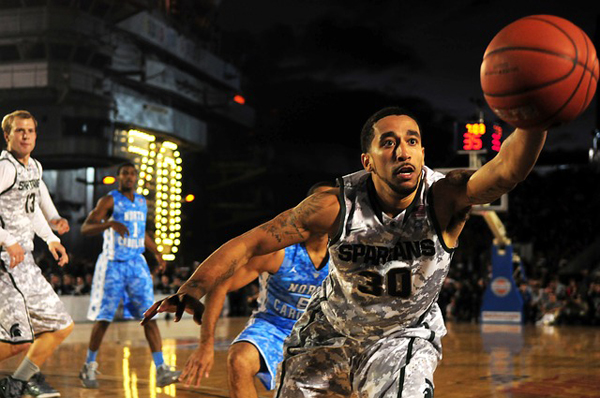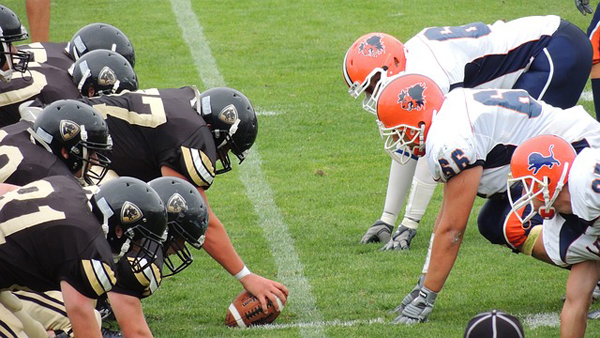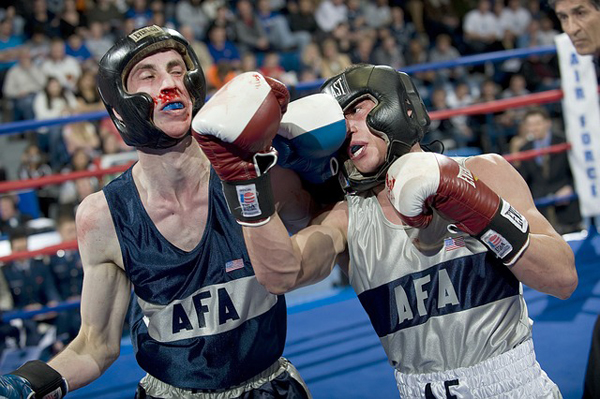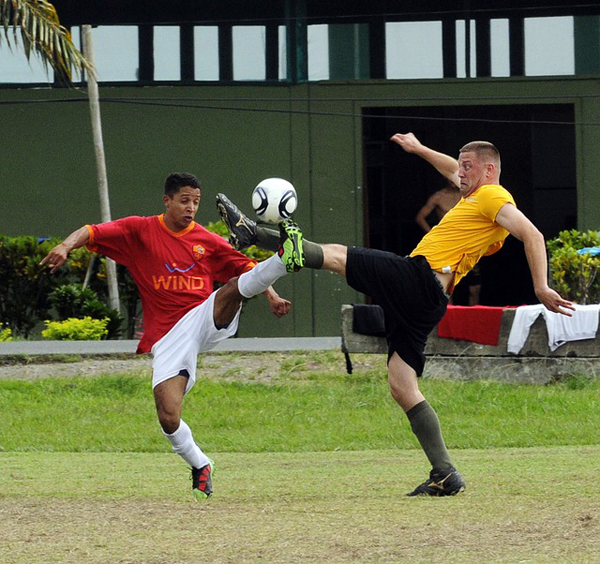
When writing a program, several steps need to be taken. The first is a Needs Analysis that contains both an evaluation of the sport and an assessment of the athlete. These two things are extremely important. Remember that the body works on the SAID principle; if the proper demands are not being imposed upon the body, they will not be adapted to, and thus, the improvement in sports skill will not happen.
Let’s start off with the first part of the needs analysis: the evaluation of the sport. This evaluation of the sport is truly three analyses in and of itself. The first is what the sport is, the second is what the style of play it is, and third is what the needs of the position are.
What is the sport?
Does it require great amounts of hypertrophy, or endurance, or speed? Is it track and field where the sport is one repetition at one event at a time, or is it a team sport like basketball? Even with this, realize that for college and high school, the sports may even be slightly different, beyond the size or weight of the implement or the size of the playing field. In college basketball there is a media time out for the first dead ball every four minutes of play. In other levels, this does not exist. For the college or professional players, they will get more structured rests throughout the game.
What is the style of play?
Realize that different styles of play are going to have differences on how to train, even for the same sport. With basketball, is it a continuous movement style of play like Mike Anderson at Arkansas is famous for (the fastest 40 minutes), or is it a run down the court, set up, and post up time and time again? Realize that basketball isn’t just basketball, soccer isn’t just soccer, and football isn’t just football. The energy demands and types of players that are needed for each are completely different. You will not likely ever see a larger, heavier type player in coach Anderson’s team be successful. Look at the current trends in college football. Many teams have gone to spread offenses which rely on spreading out the defense, even on the line. Compare this to the pro style offenses or, even better, to the four yards and a cloud of dust type offenses. The pro style and run dominant offenses require bigger, stronger, heavier road graders of offensive linemen. The spreads, which will utilize a lot of pulling and different directional strategies, require swift, agile lineman who are leaner and smaller. A very talented road grader of an offensive lineman would falter and most likely fail to see the field in a spread type offense. Likewise, the talented spread offensive lineman would not do well at all in a run heavy offense. With the demands of the style of play being so different although they are the same position, the training must vary as well. The road graders would need to work on more hypertrophy and absolute strength and the spread would need to work more on strength-speed and accelerative strength.
What are the needs of the position?
For the third point, think about the demands of the position. With football it is easy to see the differences, so we will start there. Look at the receiver position: they are constantly in single support (standing on one leg while running) and need to have a great amount of starting strength and speed strength to start quickly and get to top speed. However, look at the lineman: they are often in double support, have to accelerate against a load (the opposing lineman) and require great amounts of strength-speed and accelerative strength. Realize the differences of these positions when trying to train the sport. Their positions, while within the same sport, have a great amount of differences that exist between them. Post players and guards vary greatly as well. The posts will be required to be pressing back against another player, using strength-speed and isometric strength to maintain their position where as the guards will be using high amounts of starting strength and speed-strength as well as quick eccentric-isometric-concentric transitions to out maneuver the competition.
Movement analysis
Within this evaluation, there should be a movement analysis. What limbs are involved? Is it a primarily lower body sport, like soccer? Is there a predominance of pushing like lineman in football, or a combination of pushing and pulling like in wrestling? What planes of movement are involved? Is it a sport like track where everything is predominantly in the sagittal plane, where you run fast straight ahead and occasionally lean left? Is it a sport like baseball that relies greatly on the transverse plane? Realize that these planes of movement need to be trained if they are involved in the sport. What muscles are involved? More importantly, what muscles should be involved? Some things are more than what meets the eye. Realize that in an event like the hammer throw, there may be a tendency to try and gain speed in the transverse plane, which is a good thing, but then the priority gets lost on the maintenance of posture. Essentially, the hammer thrower has to pull a 900-pound partial deadlift to stay upright and not get pulled out of position. Know the events to know what should be working.
Physiological analysis
The next part of the needs analysis is the physiological analysis. This deals with what energy systems are utilized and when. To do this, one must truly understand the sport. At one point, two coaches were arguing over an appropriate test for conditioning for basketball. The sport coach felt that they should run a two-mile, because if they are on the court the entire time, they will be running at least that far, and they should be in shape enough to get the run done in 14 minutes. The opposing coach said, "well they do run two miles in a half, but how about giving them an hour to do so, just like they have in the game?" Know the tendencies of the sport; no sport (other than the field events in track) is entirely one energy system. All are involved. For instance, in the sport of American football, people think that the sport is entirely anaerobic. The play last six seconds at most and then they rest and go again. So, while it is true that during the six seconds of play the athlete is never getting to the aerobic energy system, they are also never getting into either fast or slow glycolysis either, which are also anaerobic energy systems. The six second play is, in actuality, an alactic event. Now, in addition to this, it must be realized that the aerobic system is what is in charge of buffering the acid in the muscle, restoring ATP, and stabilizing the body to prepare it for the next play. So, football is an aerobic, alactic sport with the alactic being nearly all immediate energy system.
Common sites for injury and their causative factors
The next step of the evaluation of the sport is the common sites for injury and their causative factors. This one often gets missed. Most people can tell you what the common injuries are for each sport. If you ask in a crowded room, “what is the most common catastrophic injury for a women’s soccer player?” You will in unison get the answer “ACL.” When you ask, “great, so what do we need to do to prevent this injury?” They will usually answer, “strength the muscles around the knee.” Realize that this is not what causes the knee injury. Typically, it is the knees caving in (genu valgus) during a change of direction (in non-contact injuries) that finally give. To prevent this, you would actually need to strengthen the external rotators of the hip to prevent the internal and medial rotation from occurring. You can strengthen the knee muscles all day long, but this will not help the body go back into proper position and thus will not decrease the risk of injury.
Assessment of the athlete
Next is an assessment of the athlete. The first thing you will need to consider is their training status. The things to examine are their prior training program, the length of participation, level of intensity, and degree of exercise technique(s). Knowing what kind of program the athlete came from makes a huge difference. Is this athlete coming in from a well-established strength and conditioning program with a reputable coach? Is this athlete coming from a place where there was not even a weight room and learned everything he knows on his own at the local YMCA? What did that athlete do there? Was it a High Intensity Training type program, powerlifting, Olympic lifting, or CrossFit? Knowing the type of program they came from allows you to know what the athlete has done or hasn’t done.
How long was the athlete in the previous program? Did they just start and were there for three weeks, or had they been there for three years? This goes a long way into knowing what types of intensities and volumes the athlete can handle. Training splits can be determined by this as well, because the athlete may need more or less to improve their performance based on what they’ve previously done. If someone is an advanced athlete, he or she can handle more volume of training at a greater frequency than someone who is a beginner. Because of this, it is important to know if the athlete needs to be given the same, more, or less volume than the other athletes who have been training in your program.
What was the intensity of the program? Did the coach routinely go at or over 90%, or did they stay very submaximal? This will affect how heavy you are able to go. If the athlete has tested and performed heavy (greater than 90%) efforts before, they will more than likely be able to start out in a more intense program. Contrarily, if the athlete has only performed bodyweight exercises, externally loaded exercises should be progressed fairly conservatively. What did the coach do for conditioning? This will effect if the athlete is predominantly aerobic or anaerobic currently which will alter what type of conditioning program is needed for that athlete to perform optimally in your program.
What was the technical degree of the program? Were there only machines? Were there dumbbells involved? Did the athletes squat or deadlift? Did they perform Olympic lifts? While someone may have been in a program for three years, they may have only performed exercises on machines, and would essentially be a beginner for Olympic lifting, learning technique, and learning to stabilize external loads. If the athlete hasn’t performed a certain exercise before, they are to start out like a beginner for that exercise, spending a great amount of time on technique before trying to increase the external load. This is an often overlooked factor, where the athlete has been trained for three years and is automatically considered an advanced trainee by the practitioner when, in reality, the athlete should start over at the beginning and learn the positions that are foreign to them.
Only after determining all of these factors of the Needs Analysis should the coach even think about selecting tests, exercises, loads, volumes, and any other factors. This all breaks down to the Specific Adaptations to Imposed Demands (SAID) principle. You will only adapt to whatever demand is specifically imposed on the body. If you aren’t aware of the needs of the sport and the athlete, you won’t be able to write the appropriate program for them.
I ended my book, Powerlifting, with a quote from my father, James Palmer Mann. He was a logistics officer for the US Army and spent the last major portion of his career in Fort Hood, as a Lieutenant Colonel. When talking about logistics and Preventative Maintenance Checks Form (PMCS) he had his Six P’s. Here is the adapted version of his 6P’s, more appropriate for the lay audience. Proper Planning Prevents Pathetically Poor Performance. Make sure to spend your time on the 6P’s for programming for your athletes. Failing to plan is the same as planning to fail.












